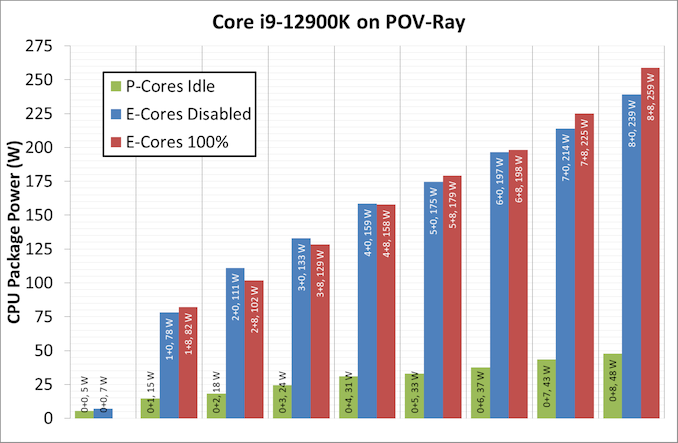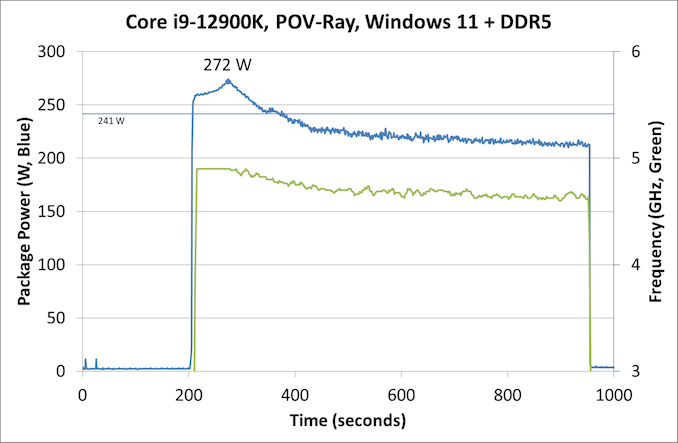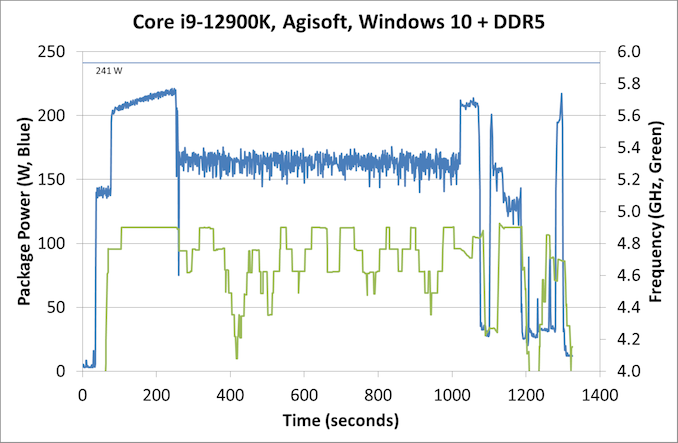The Intel 12th Gen Core i9-12900K Review: Hybrid Performance Brings Hybrid Complexity
by Dr. Ian Cutress & Andrei Frumusanu on November 4, 2021 9:00 AM ESTPower: P-Core vs E-Core, Win10 vs Win11
For Alder Lake, Intel brings two new things into the mix when we start talking about power.
First is what we’ve already talked about, the new P-core and E-core, each with different levels of performance per watt and targeted at different sorts of workloads. While the P-cores are expected to mimic previous generations of Intel processors, the E-cores should offer an interesting look into how low power operation might work on these systems and in future mobile systems.
The second element is how Intel is describing power. Rather than simply quote a ‘TDP’, or Thermal Design Power, Intel has decided (with much rejoicing) to start putting two numbers next to each processor, one for the base processor power and one for maximum turbo processor power, which we’ll call Base and Turbo. The idea is that the Base power mimics the TDP value we had before – it’s the power at which the all-core base frequency is guaranteed to. The Turbo power indicates the highest power level that should be observed in normal power virus (usually defined as something causing 90-95% of the CPU to continually switch) situation. There is usually a weighted time factor that limits how long a processor can remain in its Turbo state for slowly reeling back, but for the K processors Intel has made that time factor effectively infinite – with the right cooling, these processors should be able to use their Turbo power all day, all week, and all year.
So with that in mind, let’s start simply looking at the individual P-cores and E-cores.
Listed in red, in this test, all 8P+8E cores fully loaded (on DDR5), we get a CPU package power of 259 W. The progression from idle to load is steady, although there is a big jump from idle to single core. When one core is loaded, we go from 7 W to 78 W, which is a big 71 W jump. Because this is package power (the output for core power had some issues), this does include firing up the ring, the L3 cache, and the DRAM controller, but even if that makes 20% of the difference, we’re still looking at ~55-60 W enabled for a single core. By comparison, for our single thread SPEC power testing on Linux, we see a more modest 25-30W per core, which we put down to POV-Ray’s instruction density.
By contrast, in green, the E-cores only jump from 5 W to 15 W when a single core is active, and that is the same number as we see on SPEC power testing. Using all the E-cores, at 3.9 GHz, brings the package power up to 48 W total.
It is worth noting that there are differences between the blue bars (P-cores only) and the red bars (all cores, with E-cores loaded all the time), and that sometimes the blue bar consumes more power than the red bar. Our blue bar tests were done with E-cores disabled in the BIOS, which means that there might be more leeway in balancing a workload across a smaller number of cores, allowing for higher power. However as everything ramps up, the advantage swings the other way it seems. It’s a bit odd to see this behavior.
Moving on to individual testing, and here’s a look at a power trace of POV-Ray in Windows 11:
Here we’re seeing a higher spike in power, up to 272 W now, with the system at 4.9 GHz all-core. Interestingly enough, we see a decrease of power through the 241 W Turbo Power limit, and it settles around 225 W, with the reported frequency actually dropping to between 4.7-4.8 GHz instead. Technically this all-core is meant to take into account some of the E-cores, so this might be a case of the workload distributing itself and finding the best performance/power point when it comes to instruction mix, cache mix, and IO requirements. However, it takes a good 3-5 minutes to get there, if that’s the case.
Intrigued by this, I looked at how some of our other tests did between different operating systems. Enter Agisoft:
Between Windows 10 and Windows 11, the traces look near identical. The actual run time was 5 seconds faster on Windows 11 out of 20 minutes, so 0.4% faster, which we would consider run-to-run variation. The peaks and spikes look barely higher in Windows 11, and the frequency trace in Windows 11 looks a little more consistent, but overall they’re practically the same.
For our usual power graphs, we get something like this, and we’ll also add in the AVX-512 numbers from that page:

Compared to Intel’s previous 11th Generation Processor, the Alder Lake Core i9 uses more power during AVX2, but is actually lower in AVX-512. The difficulty of presenting this graph in the future is based on those E-cores; they're more efficient, and as you’ll see in the results later. Even on AVX-512, Alder Lake pulls out a performance lead using 50 W fewer than 11th Gen.
When we compare it to AMD however, with that 142 W PPT limit that AMD has, Intel is often trailing at a 20-70 W deficit when we’re looking at full load efficiency. That being said, Intel is likely going to argue that in mixed workloads, such as two software programs running where something is on the E-cores, it wants to be the more efficient design.














474 Comments
View All Comments
xhris4747 - Tuesday, November 9, 2021 - link
They should use pbo it's fair toxhris4747 - Tuesday, November 9, 2021 - link
Is you using pbo some people are t using pbo which I think isn't fair because that i9 is oc to snotEnglishMike - Thursday, November 4, 2021 - link
It's not just the gaming world -- it's the entire world except for long-running CPU intensive tasks. Handbrake and blender are valuable benchmarking tools for seeing what a CPU is capable of when pushed to the limit, but the vast majority of users -- even most power users -- don't do that.Sure, Intel has more work to do to improve power efficiency in long running CPU intensive workloads, but taking the worst case power usage scenarios distorts the picture as much as you're claiming the reviewers are doing.
Wrs - Thursday, November 4, 2021 - link
Can't calculate efficiency without scores. Also, well known that power scales much faster than performance. The proper way to compare efficiency is really at constant work rate or constant power.blanarahul - Thursday, November 4, 2021 - link
Sorry sir I can't. You haven't provided me the data for how much time each test took! Would you be so kind as to do that?Netmsm - Thursday, November 4, 2021 - link
Sorry, this is a direct link to Tom's bench:https://cdn.mos.cms.futurecdn.net/if3Lox9ZJBRxjbhr...
this is for "blender bmw27" in which both 12900k and 5950x finish the job around 80 seconds BUT 12900k sucks power for about 70 percent more than 5950x.
you can find other benches here:
https://www.tomshardware.com/news/intel-core-i9-12...
I'm wondering why Ian hasn't put 12900k nominal TDP in results just like all other CPU's! When 10900k was released with nominal TDP of 125, Ian put than number in every bench while in reality 10900k was consuming up to 254 (according to the Ian's review)! When I asked him to put real numbers of power consumption for every test he said I can't because of time and because I've too much to do and because I've no money to pay and delegate such works to an assistant!
But now we have 12900k with nominal TDP of 241 which seems unpleasant to Ian to put it in front of it in results.
Zingam - Friday, November 5, 2021 - link
Last gen game. How about glquake?1 billion computing devices and just a few million game units sold? What does it mean? Gamers are a tiny but vocal minority.
If they bring this performance at 5W on low and 45W on high then its good for majority of people. This is just a space heater.
Gothmoth - Friday, November 5, 2021 - link
so throwing more cores on a game that can´t make use of them is usless thanks for clarifing that.... genius!!when a 5600x is producing 144 FPS and a 5950x is producing 150 FPS the 5600x is the clear winner when it comes to efficency.
now try to cool the 12900K in a work environment with an air cooler.
i can cool my threadripper with a noctua aircooler and let it run under full load for ours.
i am really curious to see how the 12900k will handle that.
i am not an amd fanboy. i was using anti-consumer intel for a decade before switching to ryzen.
i would us intel again when it makes sense for me (i need my pc for work not gaming).
but with this power draw it does not make sense.
Wrs - Saturday, November 6, 2021 - link
The 12900k is fine with a Noctua D15 in a work environment. Doesn't matter if you're hammering it at 95C the whole time, the D15 doesn't get louder. But it's no megachip like a Threadripper. For that on the Intel side you'd wait for Sapphire Rapids or put up with an existing Xeon Gold with 8-32 Ice Lake cores at 10nm.Netmsm - Saturday, November 6, 2021 - link
How would it be justified to buy Xeon Gold in place of Threadripper and Epyc?!